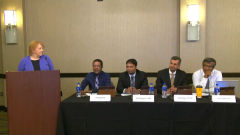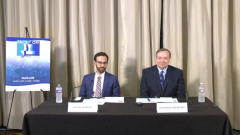
Cross Q&A: Ciltacabtagene Autoleucel in Relapsed/Refractory Multiple Myeloma
Experts from the Mayo Clinic and UT Southwestern share insight on the CARTITUDE-4 study and ciltacabtagene autoleucel in the second cross Q&A session.
Episodes in this series

Transcript:
Judy Schreiber, PhD, RN: Thank you very much, Dr Kapoor. Do you have some questions at this time?
Larry Anderson Jr, MD, PhD, FACP: Excellent presentation, exciting data. In light of these findings in earlier relapsed myeloma with cilta-cel [ciltacabtagene autoleucel], is there a group of patients you would recommend use the second line? Would you propose everyone? Is there a group of patients with certain comorbidities or other medical issues [for whom] you would avoid using this or do you think the mitigation strategies might be enough to help avoid some of the MNT [a subset of other CAR T-cell neurotoxicities] [adverse] effects?
Prashant Kapoor, MD, FACP: Again, obviously the treatment is not yet approved to be used in patients who are less heavily pretreated, but as you alluded to, Dr Anderson, patients who are having an explosive relapse wouldn’t necessarily be candidates even if this regimen or this treatment is introduced early on during the disease course. Specifically, there are some caveats in terms of the comparator arm, which, by the way, did quite well; similar to what was seen with ida-cel [idecabtagene vicleucel]. This is cross-trial comparison and, as you nicely indicated, the study populations are quite different. But a 12-month PFS [progression-free survival] in the standard-of-care arm was as expected and not necessarily lower. If available I think this would be a great option, specifically in patients who are otherwise transplant ineligible. This widens the options, and we are seeing that the adverse effects, or the rates of some of those dreaded adverse effects, are lower at least in the limited follow-up of 15 to 16 months. There weren’t cases of reported Parkinson disease as was seen in CARTITUDE-1 [NCT03548207]; barring 1 case of MNT [adverse effects] that has been seen so far. These are some of the things that must be taken into account. We ignore the fact that these patients are going to receive fludarabine and cyclophosphamide DNA-damaging agents. I have next to me Dr Mangaonkar, who deals with the adverse consequences of using these agents once patients start experiencing myeloid malignancies, treatment-related myeloid neoplasms…. We must take all that into account, patients who have been previously exposed to high-dose melphalan and may have a higher likelihood of developing some of these dreaded complications. So whether we can truly pull the trigger earlier on during the disease course still remains to be seen. Lastly, I would say, in terms of the standard-of-care arm, I think there were some more potent standard-of-care arms that could have potentially been used. I understand the investigators and the sponsor had their reasons for not using, but as Dr Gonsalves will soon show us, the data with the IKEMA study [NCT03275285], which used isatuximab in combination with carfilzomib and dexamethasone, or data with CANDOR study [NCT03158688], which used daratumumab in combination with carfilzomib and dexamethasone, were exceedingly promising, although the [number of patients who] were lenalidomide refractory was much lower, as opposed to 100% in the current CARTITUDE-4 study [NCT04181827].
Adeel Khan, MD, MPH, MS: Thank you for the excellent presentation, Dr Kapoor. My question dovetails on what you already alluded to a bit. CAR [chimeric antigen receptor] T-cell therapy is all the rage, and we saw cilta-cell have phenomenal PFS numbers in CARTITUDE-1, and the motivation to move it up in earlier lines of therapy is certainly there. But how valid is a comparator of PVd [pomalidomide, bortezomib, and dexamethasone] or DPd [daratumumab, pomalidomide, and dexamethasone]? Especially in the era where quadruplets have become front line and these patients will be exposed to proteasome inhibitors much earlier on. We have so many great off-the-shelf options for second, third, fourth line already available that would then not require us to deal with the manufacturing issues and all the logistical issues that come into play with CAR T-cell therapy.
Prashant Kapoor, MD, FACP: You are absolutely spot on, Dr Khan. I think those are some of the challenges that [were] not encountered in this trial because even though the trial accrued fast over a course of 18 to 19 months, it is still old for all practical purposes, which speaks to the degree of progress that has been made in the field, and we are unable to catch up with the rapid pace of progress.
Kebede Begna, MD: I want to make 2 comments. One regarding therapy related myeloid neoplasm: You are not only giving them therapy-related myeloid neoplasm, you are making them older. Yesterday I saw a patient who was diagnosed in 2010 with multiple myeloma, transplant, all the treatment, and now she is 80. The other thing I see a lot of is patients with acute leukemia and MRD [minimal residual disease]. We have changed the way we manage [their disease], and I see that there is a deep MRD negative in both what Prashant and Kapoor presented. What do you think is the relapse rate after they achieve MRD negative? I see acute lymphoblastic leukemia [patients who] are MRD negative. We don’t do transplant, and soon after they stop the treatment within a matter of months [they relapse], and the patient is shocked and we are also shocked. Do you see a relapse after MRD negative? Actually, is there any report on both the papers that you have presented? Thank you.
Prashant Kapoor, MD, FACP: So as it relates to CARTITUDE-4, they haven’t quite given us that, but we can see even though the vast majority of patients had achieved MRD-negative status at least with the 10–5 sensitivity, we did not quite see the plateau in CARTITUDE 1 study. Here the follow-up is rather short, and it’s hard to say most of the patients are continuing to remain progression free at 12 months. But I think if we were to compare this with CARTITUDE-1 data, it seems fairly similar to me, and so it is unlikely that we would see a plateauing of the curve, but perhaps Wilson can speak more to that.
Wilson Gonsalves, MD: Sure. I think it’s a great question. My thoughts on MRD negativity is that it is prognostic and it’s a moving target. I think MRD negativity in 2023 is next-generation sequencing, next gen flow, 10–5, 10–6.… I don’t think MRD negativity equals cure; that’s what I try to tell patients. I think it is prognostic. The deeper the response you get it seems to translate into better overall survival, but I don’t necessarily think it equals telling patients, “You are MRD negative, you’re going to be cured.” Especially for the high-risk patients: Almost all of them—even those who are MRD negative—still relapse.
Transcript edited for clarity.
Newsletter
Stay up to date on recent advances in the multidisciplinary approach to cancer.



















































































